
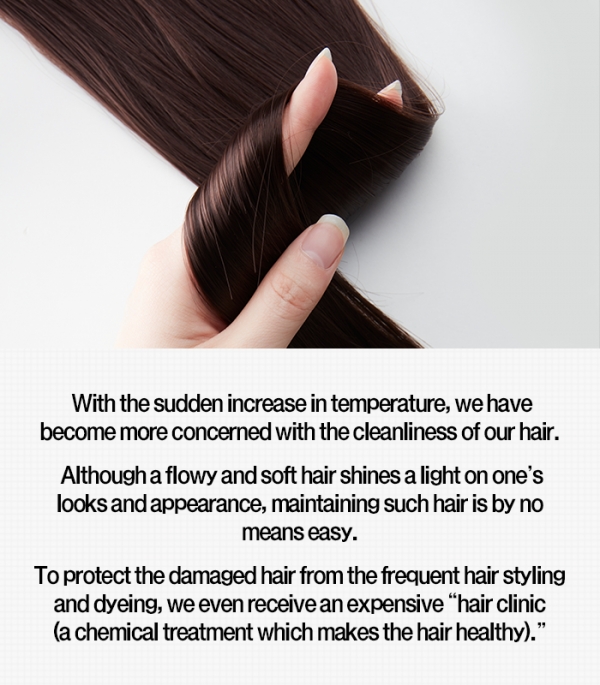
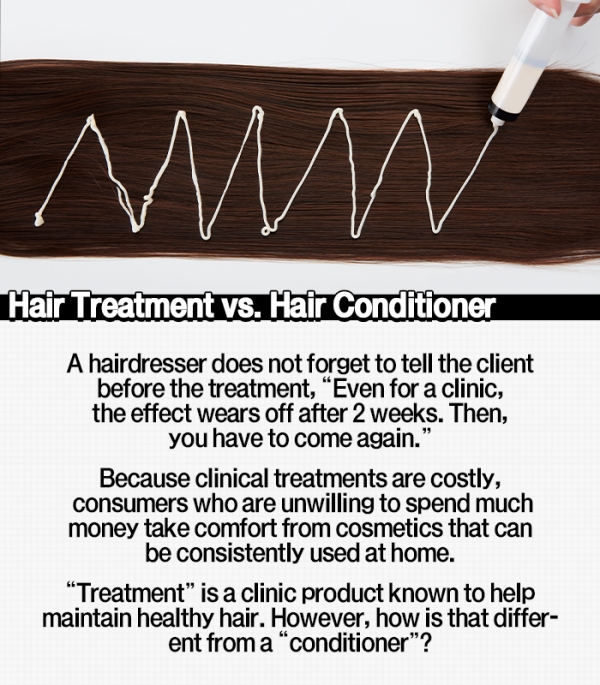


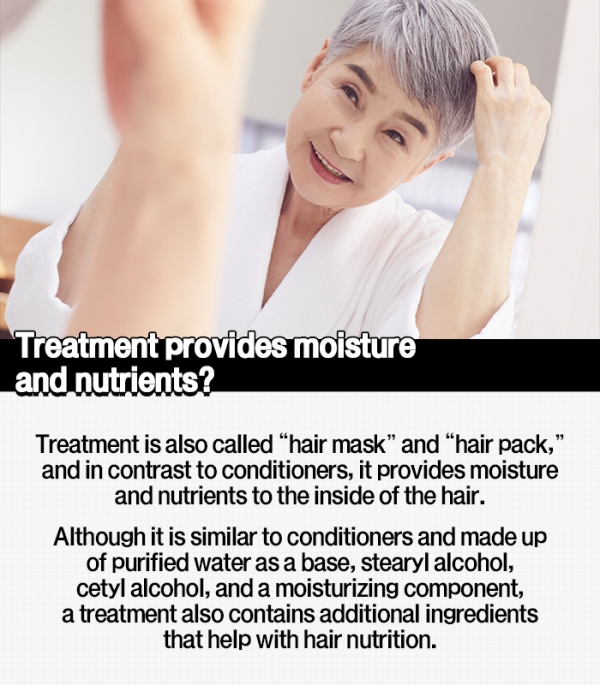


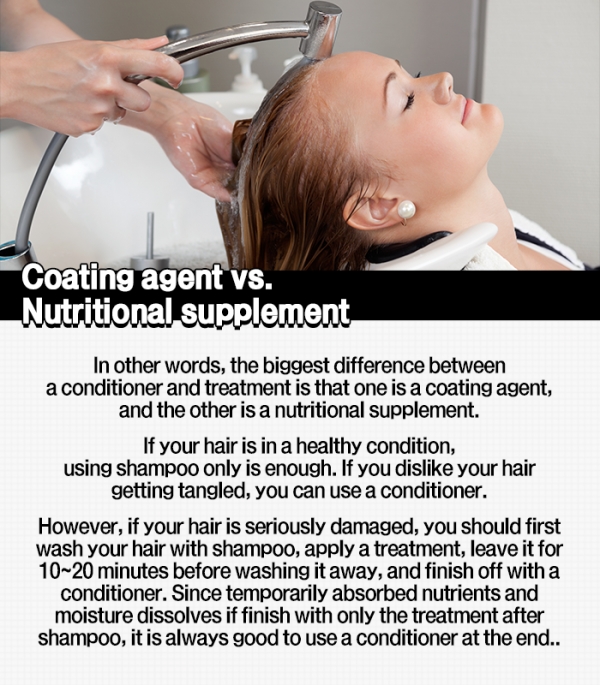
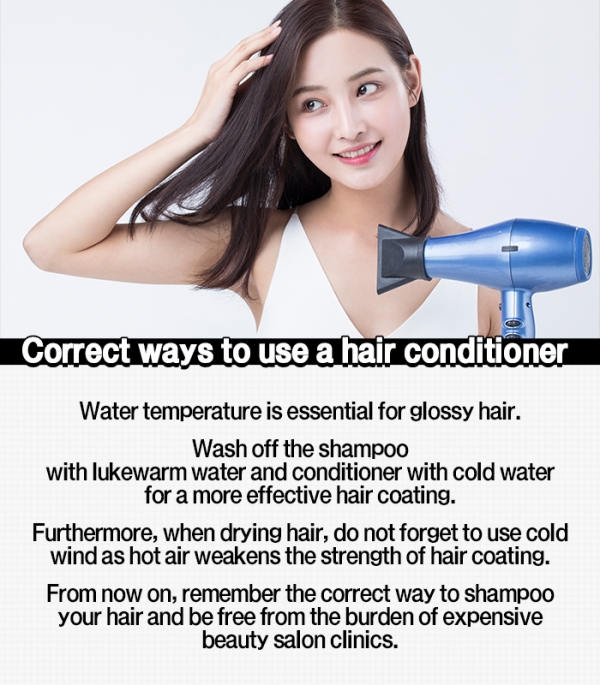

With the sudden increase in temperature, we have become more concerned with the cleanliness of our hair.
Although a flowy and soft hair shines a light on one’s looks and appearance, maintaining such hair is by no means easy.
To protect the damaged hair from the frequent hair styling and dyeing, we even receive an expensive “hair clinic (a chemical treatment which makes the hair healthy).”
CARD 1. Hair Treatment vs. Hair Conditioner
A hairdresser does not forget to tell the client before the treatment, “Even for a clinic, the effect wears off after 2 weeks. Then, you have to come again.”
Because clinical treatments are costly, consumers who are unwilling to spend much money take comfort from cosmetics that can be consistently used at home.
“Treatment” is a clinic product known to help maintain healthy hair. However, how is that different from a “conditioner”?
CARD 2. “Conditioner” brings back slightly acid
Because the hair temporarily becomes slightly alkaline when you wash your hair with shampoo, you have to neutralize it with a conditioner to restore sub-acidity.
This is the same concept as restoring sub-acidity by applying a toner after washing your face.
Conditioner is made up of purified water as the basic ingredient, surfactants such as stearyl alcohol and cetyl alcohol, a moisturizer like glycerin, and a coating agent like silicone oil.
Since the silicone component can cause skin troubles on the scalp if not completely rinsed off, you must thoroughly wash your hair after using a conditioner.
CARD 3. Conditioner temporarily acts only on the hair cuticle
Conditioner is also called a “rinse” and temporarily coats the hair strands to protect from harmful substances like fine dust.
Simultaneously, it helps prevent the moisture and nutrients from easily dissolving and acts as a buffer by reducing friction among hair strands.
Through this, it lessens hair tangling, maintaining soft hair.
However, because conditioner temporarily acts on only the hair cuticle or hair surface, it rinses off when you wash your hair. As a result, it does not fundamentally help recover damaged hair.
CARD 4. Treatment provides moisture and nutrients?
Treatment is also called “hair mask” and “hair pack,” and in contrast to conditioners, it provides moisture and nutrients to the inside of the hair.
Although it is similar to conditioners and made up of purified water as a base, stearyl alcohol, cetyl alcohol, and a moisturizing component, a treatment also contains additional ingredients that help with hair nutrition.
CARD 5. Treatment is for hair damage prevention, not recovery
Most treatments contain “LPP (Low Poly Peptide)” or “PPT (Poly Peptide)” as ingredients. These are proteins with low molecular weight, temporarily filling in the cuticles of a perforated hair.
Besides, treatments also contain soybean seed extract, shea butter, jojoba oil, and coconut oil to provide nutrient supply, form a thin oil film at the cuticle, and help to prevent hair damage. However, treatments do not completely recover the hair.
CARD 6. The correct way to use hair treatments
Because protein of once damaged hair does not naturally recover, treatments improve hair condition by infusing hair with nutrients, moisture, and oil.
Hence, if you want to keep the effects for a long time, wait for around 10~20 minutes until the treatment penetrates the hair before lightly washing it away for the best effect.
Since treatments may cause irritations like conditioners if contact the scalp, apply it only on your hair, and thoroughly wash up to your scalp at the end.
CARD 7. Coating agent vs. Nutritional supplement
In other words, the biggest difference between a conditioner and treatment is that one is a coating agent, and the other is a nutritional supplement.
If your hair is in a healthy condition, using shampoo only is enough. If you dislike your hair getting tangled, you can use a conditioner.
However, if your hair is seriously damaged, you should first wash your hair with shampoo, apply a treatment, leave it for 10~20 minutes before washing it away, and finish off with a conditioner. Since temporarily absorbed nutrients and moisture dissolves if finish with only the treatment after shampoo, it is always good to use a conditioner at the end.
CARD 8. Correct ways to use a hair conditioner
Water temperature is essential for glossy hair.
Wash off the shampoo with lukewarm water and conditioner with cold water for a more effective hair coating.
Furthermore, when drying hair, do not forget to use cold wind as hot air weakens the strength of hair coating.
From now on, remember the correct way to shampoo your hair and be free from the burden of expensive beauty salon clinics.


